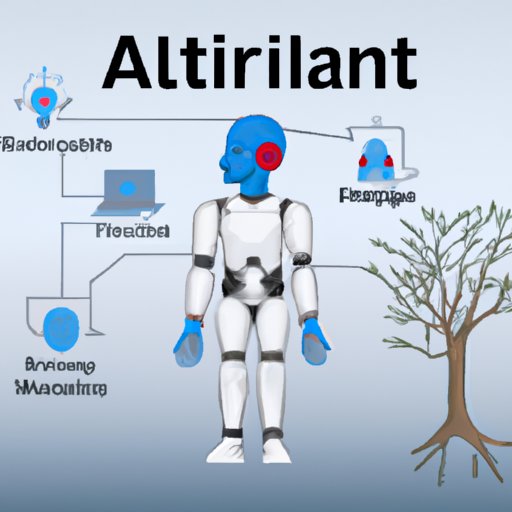Introduction
Artificial intelligence (AI) is the science of making machines that can think and act like humans. It has been around for decades but has only recently become more prevalent due to the advances in computing power and data availability. AI has the potential to revolutionize many industries and areas of our lives, from healthcare and transportation to education and business.
The purpose of this article is to provide an overview of how to apply artificial intelligence in various scenarios. We will look at understanding the basics of AI, evaluating potential applications for AI, developing a strategy to implement AI, testing, monitoring, and improving AI performance, and exploring new opportunities with advanced AI technologies.

Understanding the Basics of Artificial Intelligence
Before we can begin to understand how to apply artificial intelligence, it is important to understand the basics of AI. This includes understanding the different types of AI technologies, the various AI algorithms, and the benefits of using AI.
Types of AI Technologies – There are several types of AI technologies, each with its own advantages and disadvantages. The most common types of AI include machine learning, deep learning, neural networks, computer vision, natural language processing, and robotics.
AI Algorithms – AI algorithms are the mathematical models used to teach computers how to think and act. These algorithms can be used to solve problems and make decisions based on data. Common AI algorithms include supervised learning, unsupervised learning, reinforcement learning, and evolutionary algorithms.
Benefits of Using AI – There are many benefits of using AI, including increased efficiency, improved accuracy, faster decision-making, and cost savings. Additionally, AI can be used to automate tasks and processes, allowing businesses to focus on higher-value activities.

Evaluating Potential Applications for Artificial Intelligence
Once you understand the basics of AI, the next step is to evaluate potential applications for AI. This involves identifying areas where AI can help, assessing potential risks and opportunities, and determining whether AI is the right solution for the problem at hand.
Identifying Areas Where AI Can Help – To identify areas where AI can help, it is important to understand the problem or process you are trying to optimize. Once you have identified the problem, you can then analyze the data and determine if AI is the right solution. It is also important to consider any ethical implications of using AI.
Assessing Potential Risks and Opportunities – When evaluating potential applications for AI, it is also important to assess the potential risks and opportunities associated with using AI. This includes understanding the impact of AI on privacy, security, and human jobs, as well as the potential for bias in AI algorithms.

Developing a Strategy to Implement Artificial Intelligence
Once you have evaluated potential applications for AI, the next step is to develop a strategy to implement AI. This involves choosing the right technology and tools, establishing goals and objectives, defining success metrics, and designing a plan to deploy AI.
Choosing the Right Technology and Tools – When choosing the technology and tools for your AI project, it is important to consider factors such as cost, scalability, and compatibility with existing systems. Additionally, it is important to understand the capabilities of the technology and tools you are considering.
Establishing Goals and Objectives – It is important to set clear goals and objectives for your AI project. This includes defining the expected outcomes and the timeline for achieving them. Additionally, it is important to establish criteria for measuring success.
Defining Success Metrics – To ensure that your AI project is successful, it is important to define key success metrics. This includes defining the KPIs (Key Performance Indicators) that will be used to measure the success of the project.
Testing, Monitoring, and Improving AI Performance
Once you have implemented AI, it is important to test, monitor, and improve AI performance. This involves establishing testing protocols, monitoring performance, and making adjustments to ensure that the AI is performing as expected.
Establishing Testing Protocols – Before deploying AI, it is important to establish testing protocols. This includes testing the AI system against real-world data and scenarios to ensure accuracy and reliability.
Monitoring Performance – After the AI system has been deployed, it is important to monitor performance and adjust parameters as necessary. This includes tracking KPIs and making changes to the system based on the results.
Making Adjustments – As the AI system is used, it is important to make adjustments to ensure that it continues to perform as expected. This includes adjusting parameters, retraining the system, and updating data sets.
Exploring New Opportunities with Advanced AI Technologies
Finally, it is important to explore new opportunities with advanced AI technologies. This includes AI-driven automation, machine learning, and natural language processing. By utilizing these technologies, businesses can gain a competitive edge and unlock new possibilities.
AI-Driven Automation – AI-driven automation is the use of AI to automate tasks and processes. This can be used to streamline workflows and reduce manual effort, resulting in improved efficiency and cost savings.
Machine Learning – Machine learning is a type of AI that allows computers to learn from data and improve over time. This can be used to build intelligent systems that can make predictions and decisions without human intervention.
Natural Language Processing – Natural language processing (NLP) is the ability of a computer to understand and interpret human language. This can be used to develop voice-enabled applications, such as virtual assistants and chatbots.
Conclusion
In conclusion, applying artificial intelligence can be a powerful tool for businesses looking to gain a competitive advantage. This article has provided an overview of how to apply AI, including understanding the basics of AI, evaluating potential applications, developing a strategy to implement AI, testing, monitoring, and improving AI performance, and exploring new opportunities with advanced AI technologies.
By following the steps outlined in this article, businesses can utilize AI to unlock new possibilities and gain a competitive edge. With the right strategy and implementation, AI can be a powerful tool for businesses of all sizes.
(Note: Is this article not meeting your expectations? Do you have knowledge or insights to share? Unlock new opportunities and expand your reach by joining our authors team. Click Registration to join us and share your expertise with our readers.)
